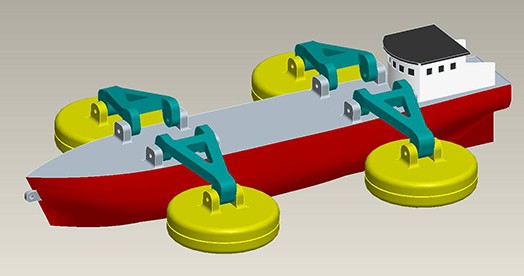Electrical Power Generation from Ocean Waves
Fraunhofer USA CMI is pursuing a solution to overcome drawbacks of traditional wave energy harvesting
Conventional approaches to harvesting energy from ocean waves and currents suffer from at least three major drawbacks: 1) expensive underwater power transmission cables, 2) storm damage susceptibility, and 3) energy output cannot be scheduled according to demand. These factors translate into more expensive electricity (cost/KWH). Consequently, market economics hinder deployment and use of ocean energy, and the technology is only moving forward due to government incentives.
Mobile wave-energy harvesting boats could bring cheaper clean electricity
Fraunhofer USA CMI is pursuing an economically viable, alternative method of harvesting ocean wave energy, comprised of a boat with an on-board wave energy harvesting system, and on-board energy storage capacity. A typical system consists of 50 meter boat with 1 MW capacity wave energy harvesting equipment and 20 MWH of energy storage capability. Operationally, the boat cruises to a favorable location off-shore, harvests energy for approximately 20 hours, cruises back to shore, connects to the electricity grid, and releases the stored energy during high demand periods. Preliminary calculations promise initial electricity cost of 15 cents per KWh. The proposed concept is a modular, distributed energy system in which numerous such small boats harvest wave energy off the entire coast-line. This means that the energy is produced near the point of use, eliminating the need for new infrastructure, like high power transmission lines typically needed for wind energy, or special docking facilities, as conventional marinas suffice.
Technical Summary
- Harvests wave energy with daily trips to offshore locations and returns back to port for delivery to the grid
- Energy is stored locally on the vessel during harvesting phase
- Energy is placed on the grid during periods of high demand (normally mid-day)
- Eliminates expensive undersea power cables needed for other wave energy technologies
- Can be moved safely to port during severe storms
- Overcomes regulatory hurdles by not being a permanent structure
